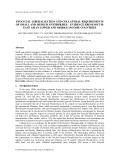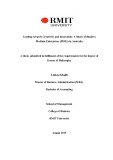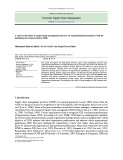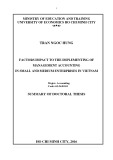
TNU Journal of Science and Technology
230(03): 69 - 77
http://jst.tnu.edu.vn 69 Email: jst@tnu.edu.vn
ROLE OF CUSTOMER-CENTRIC APPROACH AND ENTREPRENEURIAL
ORIENTATION ON INNOVATION AMBIDEXTERITY OF SMES IN VIETNAM
Mac Thuy Ngan, Nguyen Thi Hanh*, Tran To Quyen, Duong Huong Giang, Trinh Thi Tieu Mai,
Phan Ha Le
Foreign Trade University
ARTICLE INFO
ABSTRACT
Received:
11/12/2024
This study examines the impact of a customer-centric approach and
entrepreneurial orientation on innovation ambidexterity in Vietnamese
small and medium enterprises. Although research on innovation
ambidexterity has primarily focused on large firms, studies addressing
the unique challenges small and medium enterprises face in balancing
explorative and exploitative innovation, especially within the
Vietnamese context remain limited. Using PLS-SEM analysis on data
from 142 small and medium enterprises managers and team leaders,
the findings reveal that both customer-centricity and entrepreneurial
orientation positively influence ambidextrous innovation.
Additionally, entrepreneurial orientation mediates this relationship,
helping small and medium enterprises address both emerging and
current market demands. This research enriches the literature of
innovation ambidexterity by applying the Resource-Based View and
Dynamic Capability Theory to small and medium enterprises in a
developing market and offers practical managerial implications for
these firms.
Revised:
27/3/2025
Published:
28/3/2025
KEYWORDS
Customer-centric approach
Entrepreneurial orientation
Innovation ambidexterity
Small and medium enterprises
PLS-SEM
VAI TRÒ CỦA CÁCH TIẾP CẬN LẤY KHÁCH HÀNG LÀM TRUNG TÂM VÀ
ĐỊNH HƯỚNG SÁNG NGHIỆP ĐỐI VỚI TÍNH THUẬN CẢ HAI TAY
TRONG ĐỔI MỚI CỦA CÁC DOANH NGHIỆP VỪA VÀ NHỎ
Mạc Thuý Ngân, Nguyễn Thị Hạnh*, Trần Tố Quyên, Dương Hương Giang, Trịnh Thị Tiểu Mai,
Phan Hà Lê
Trường Đại học Ngoại thương
THÔNG TIN BÀI BÁO
TÓM TẮT
Ngày nhận bài:
11/12/2024
Nghiên cứu này xem xét tác động của cách tiếp cận lấy khách hàng
làm trung tâm và định hướng sáng nghiệp đối với khả năng đổi mới
thuận cả hai tay trong các doanh nghiệp vừa và nhỏ tại Việt Nam.
Trong khi các đối tượng nghiên cứu trước đó thường là các tập đoàn
lớn, nghiên cứu về các thách thức đặc thù mà các doanh nghiệp vừa
và nhỏ đối mặt trong việc cân bằng giữa đổi mới mang tính khám phá
và cải tiến, đặc biệt là trong bối cảnh Việt Nam, vẫn còn hạn chế.
Phân tích PLS-SEM dữ liệu sơ cấp thu thập từ 142 quản lý và lãnh
đạo nhóm tại các doanh nghiệp vừa và nhỏ cho thấy cả hai yếu tố này
đều tác động tích cực đến khả năng đổi mới thuận cả hai tay. Định
hướng sáng nghiệp đóng vai trò trung gian, giúp các doanh nghiệp
vừa và nhỏ đáp ứng nhu cầu thị trường hiện có và tiềm năng. Nghiên
cứu này đóng góp vào chủ đề đổi mới sáng tạo thuận cả hai tay khi
ứng dụng Lý thuyết Nguồn lực và Lý thuyết Năng lực Động vào các
doanh nghiệp vừa và nhỏ tại một thị trường đang phát triển và đề
xuất hàm ý quản trị cho các doanh nghiệp này.
Ngày hoàn thiện:
27/3/2025
Ngày đăng:
28/3/2025
TỪ KHÓA
Lấy khách hàng làm trung tâm
Định hướng sáng nghiệp
Khả năng đổi mới thuận cả hai tay
Doanh nghiệp vừa và nhỏ
PLS-SEM
DOI: https://doi.org/10.34238/tnu-jst.11679
* Corresponding author. Email: hanhnt@ftu.edu.vn

























